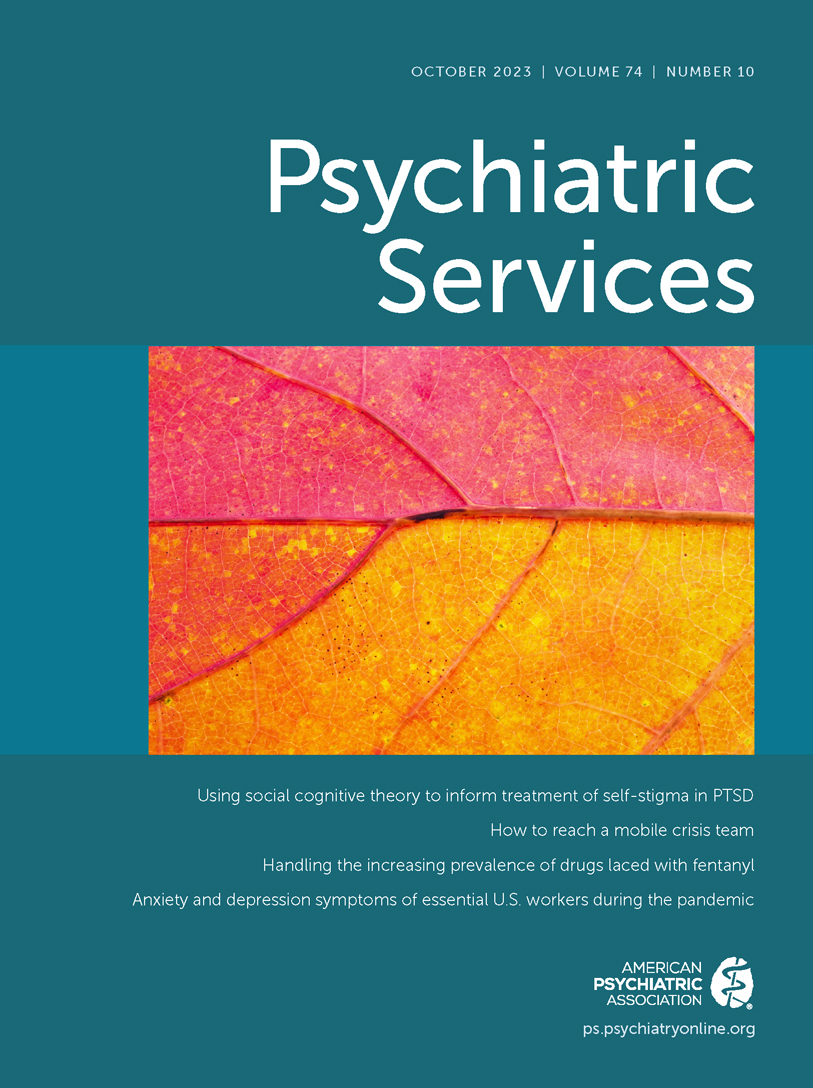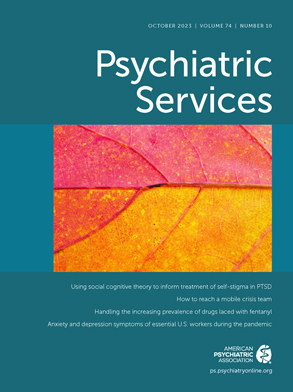Self-stigma—the internalization of others’ prejudices of mental illness—is associated with negative outcomes, including depression, suicidal ideation, poor recovery, and lower treatment engagement (
1,
2), and is recognized as an important treatment target for individuals with serious mental illness, including schizophrenia, substance use disorder, bipolar disorder, and chronic depression (
2). Interventions designed to ameliorate self-stigma are effective for managing these disorders (
3).
However, research on self-stigma among individuals with posttraumatic stress disorder (PTSD) is more nascent and therefore limited. A few small-sample studies that have examined self-stigma among individuals diagnosed as having PTSD suggest that self-stigma may be common, a significant barrier to treatment seeking and engagement, and associated with greater symptom burden (
4,
5). In fact, in a sample of veterans in a partial psychiatric hospitalization program, self-stigma was more prevalent among individuals with PTSD compared with other serious mental illnesses (
6). PTSD and self-stigma are similar in core aspects, such as negative appraisal of one’s diagnosis and functioning (i.e., a core aspect of self-stigma) and the PTSD symptom of negative beliefs about oneself (
7), which may partially explain the co-occurrence of both conditions. Social cognitive theory, wherein behaviors are learned through modeling of expectations and reinforcements, may explain how this type of negative self-view arises and maintains both self-stigma and PTSD.
Social Cognitive Theory of Self-Stigma and PTSD
The social cognitive model of self-stigma suggests that an individual learns and accepts public stereotypes about mental illness itself or the symptoms associated with it. When the stereotypes become personally relevant because of, for example, a mental health diagnosis or seeking treatment for a mental illness, the stereotypes lead to “self-concurrence,” and the stereotypes are applied to oneself. When stereotypes are particularly negative, or the individual strongly identifies with the diagnostic label, they can lead to internalized stigma, which can result in poor outcomes (
8).
The social cognitive theory of PTSD, which guides one of the frontline treatments for PTSD—cognitive processing therapy (CPT) (
9)—posits that individuals develop PTSD through a disruption in their socially learned schemas about themselves, other people, and the world. The discrepancies between their schemas before and after the traumatic event can then lead to negative beliefs about self, others, and world—a symptom of PTSD (
7). These negative beliefs can take the form of overaccommodated beliefs—wherein a person’s schema is altered to make sense of the traumatic event (e.g., “No one can be trusted”)—or assimilated beliefs—wherein the narrative of the trauma is changed to fit preexisting schemas (e.g., “It’s my fault this happened”) (
9).
Overaccommodated or assimilated beliefs about the self may resemble self-stigmatizing thoughts such as “I am broken,” or “I am weak.” Negative cognitions about the self that are also self-stigmatizing may be particularly salient for certain trauma types where societal and cultural stigmas are high, such as survivors of military trauma and sexual assault. For veterans, the military culture’s “warrior ethos” and traditional masculine norms associate help seeking with weakness and promote the myth that PTSD results only from direct exposure to an extreme life-threatening scenario, as opposed to, for example, witnessing severe human suffering. For people who have experienced sexual assault, self-stigma may manifest as self-blaming thoughts (e.g., “This assault happened because of the way I acted”). In both examples, societal expectations (e.g., “Service members are resilient” and “Sexual advances always are invited”) may become internalized, and when they do not map onto the traumatic event (e.g., freezing in a firefight, sexual assault, or other nonconsensual sexual trauma) or the person’s perceived posttrauma functioning, negative beliefs about oneself develop and contribute to the maintenance of PTSD symptomatology.
Under both the social cognitive theory of self-stigma and PTSD, internalized negative thoughts or beliefs about oneself give rise to negative emotions and maladaptive behaviors. The core affective components of self-stigma include feelings of shame and personal worthlessness (
10). For those with self-stigma related to PTSD, shame may be tied to their decrease in functioning due to PTSD or their engagement in treatment. Under the social cognitive model of PTSD, shame and worthlessness stem from assimilated beliefs (e.g., “If I had been braver, my buddy would not have died”). Such a belief may trigger feelings of guilt about the event that then generalize into overaccommodated beliefs (e.g., “I am worthless”) that subsequently trigger feelings of shame, captured by the PTSD symptom of strong negative emotions (
7).
Similarly, behavioral components of self-stigma may overlap with some behavioral components of PTSD. Specifically, self-stigmatizing beliefs can lead a person to socially isolate (if the person believes that they are dangerous) and use avoidant coping (if the person believes that they are not “worthy” of others’ company). Both are behavioral symptoms of PTSD that are conceptualized as the consequences of overaccommodated or assimilated beliefs (e.g., “I am worthless, and therefore, I shouldn’t be around people”) and thus explained by the social cognitive model of PTSD.
Cultural Considerations
A core tenet of social cognitive theory is that societal or cultural stereotypes about mental illness, or the symptoms associated with mental illness, become internalized. Therefore, cultural identity factors are vital to conceptualizing the potential interaction between self-stigma and PTSD within an individual. The detrimental impact of public stereotypes about individuals with mental illness (i.e., societal stigma) may be particularly salient for sexual, gender, racial and ethnic, and other minority groups who also experience stigma related to any historically marginalized identities they carry. Moreover, as with the military culture described above, certain racial and ethnic cultures may adhere to culture-specific social constructs that discourage help seeking and promote self-reliance in the face of stress (e.g., the concept of
machismo in the Latinx culture) (
11), thereby leading to greater internalization of stigmatizing beliefs about mental illness.
Future Directions
Self-stigma and PTSD share core cognitive, affective, and behavioral experiences and symptoms, which may explain the potentially high prevalence of self-stigma among those with PTSD (
6). Social cognitive theory appears to explain how these shared cognitive, affective, and behavioral experiences arise and are maintained in self-stigma and PTSD. Yet, this theory has not been directly empirically tested. To test the proposed model, researchers could collect observational longitudinal data to examine which aspects of self-stigma (e.g., stereotype agreement) predict the theorized related symptoms of PTSD (e.g., negative beliefs about self and avoidance of social contacts).
Another approach to determining whether PTSD and self-stigma share experiences and symptoms explained by social cognitive theory could be studies of treatments for PTSD and self-stigma that already apply a social cognitive framework. According to the social cognitive model of PTSD, we would expect that a social cognitive treatment would change a person’s agreement with societal stereotypes about PTSD, which in turn would affect PTSD symptoms related to cognitions and beliefs, which would then change related behaviors and emotions (e.g., social isolation and shame). It is unclear whether existing interventions that target self-stigma in PTSD also affect theoretically related PTSD symptoms, mainly negative beliefs about oneself. For example, Ending Self-Stigma for PTSD (ESS-P) (
12), a manualized group therapy developed to address self-stigma among veterans with PTSD, encourages participants to directly challenge societal stereotypes about PTSD and any of those stereotypes they have internalized and that focus on aspects of their identity not tied to their diagnosis. In a pilot trial (N=57), individuals in the ESS-P group had significantly greater decreases in self-stigma and depressive symptoms compared with those in a control group; decreases in PTSD symptoms (which were not an intervention target) did not significantly differ (
12). However, this trial examined PTSD total scores, rather than changes at the symptom or cluster level. Similar findings and limitations exist for two other self-stigma interventions tailored for PTSD—Tell Your Story and AboutFace (
13,
14).
Finally, because CPT is grounded in social cognitive theory, evidence for the proposed capacity of the social cognitive model for explaining self-stigma and PTSD could come from CPT trial studies, especially if clinicians explicitly measure self-stigmatizing beliefs during treatment. However, to our knowledge, no study has directly examined the efficacy of CPT in reducing self-stigma or whether self-stigmatizing thoughts are addressed as part of treatment.
Clinical Considerations
As outlined above, it is too soon to know whether social cognitive theory accurately explains the co-occurrence of self-stigma and PTSD. If evidence amasses to support this hypothesis, we note potentially important clinical considerations. First, clinicians treating individuals with PTSD may want to regularly assess their patients for self-stigma and, if it is present, consider conceptualizing and addressing their patients’ chief problems by using a social cognitive framework. Although evidence as to whether CPT directly addresses self-stigma is limited thus far, because CPT is grounded in the social cognitive framework, it may be a viable treatment for patients with high levels of self-stigma and PTSD. Alternatively, interventions based on the social cognitive model specifically designed to address self-stigma could also be clinically useful. Finally, given the role of societal and cultural influences on self-stigma, it would be important for clinicians to consider a patient’s cultural context and how this context may influence self-stigma in PTSD.
Conclusions
Self-stigma in PTSD warrants further attention because it may help explain problems with treatment adherence (
5) and is a potentially overlooked distressing challenge for people with PTSD. Social cognitive theory parsimoniously explains how co-occurrence of PTSD and self-stigma develops. As such, clinical interventions based on this theory, including CPT or self-stigma interventions (e.g., ESS-P), could address these concerns. However, more research is needed to confirm that a social cognitive framework adequately explains the co-occurrence of PTSD and self-stigma and to examine which treatments effectively reduce symptoms of these two conditions simultaneously. Clinicians may find that routinely assessing and addressing self-stigma could improve PTSD treatment engagement and retention and improve long-term outcomes.

